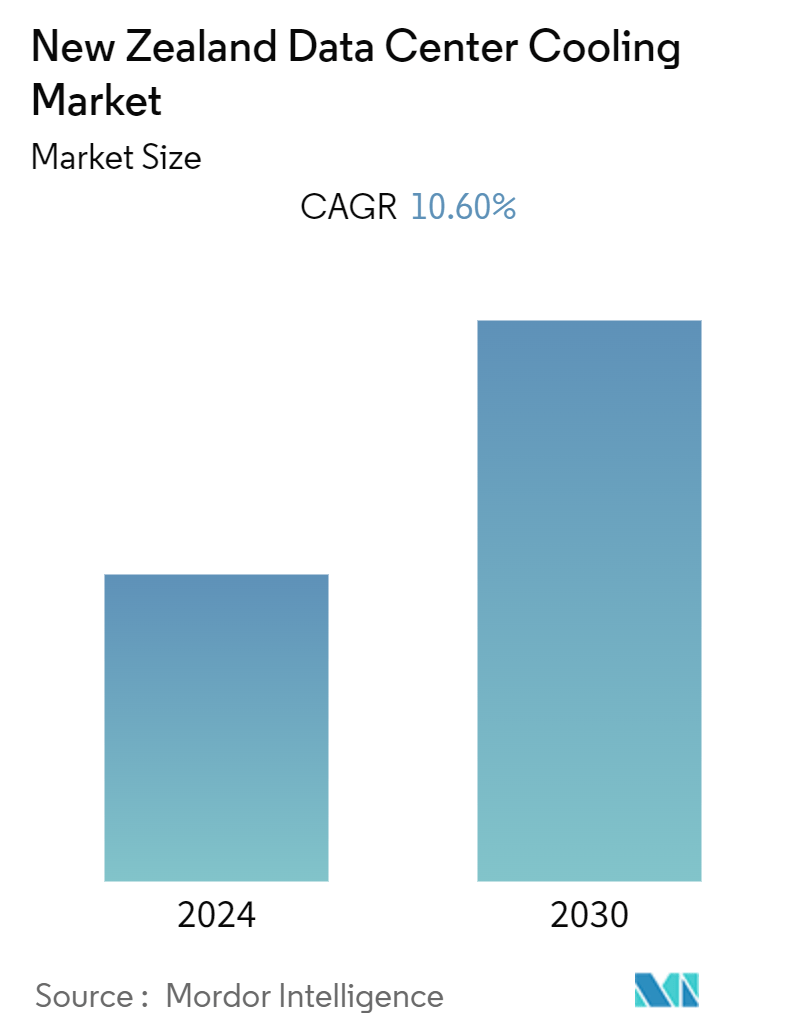Market Size of New Zealand Data Center Cooling Industry

| Study Period | 2019 - 2030 |
| Base Year For Estimation | 2023 |
| Forecast Data Period | 2024 - 2030 |
| Historical Data Period | 2019 - 2022 |
| CAGR (2024 - 2030) | 10.60 % |
| Market Concentration | Medium |
Major Players
*Disclaimer: Major Players sorted in no particular order |
New Zealand Data Center Cooling Market Analysis
The New Zealand Data Center Cooling Market is expected to register a CAGR of 10.60% during the forecast period.
The New Zealand data center rack market reached a value of USD 40.1 million in the previous year, and it is further projected to register a CAGR of 10.6% during the forecast period.
- The increasing demand for cloud computing among SMEs, government regulations for local data security, and growing investment by domestic players are some of the major factors driving the demand for data centers in the country/region.
- The upcoming IT load capacity of the New Zealand data center market is expected to reach 350 MW by 2029. The country's construction of raised floor area is expected to increase to 800K sq. ft by 2029.
- The country's total number of racks to be installed is expected to reach 35K units by 2029. Auckland is expected to house the maximum number of racks by 2029. New Zealand's average annual temperatures range from 10°C in the south to 16°C in the north.
- There are close to 8 submarine cable systems connecting New Zealand, and many are under construction. One such submarine cable that is estimated to start service in 2025 is Hawaiki Nui, which stretches over 25,000 Kilometers with landing points from Christchurch, New Zealand; Dunedin, New Zealand; and Invercargill, New Zealand.
New Zealand Data Center Cooling Industry Segmentation
Data center cooling is a set of techniques and technologies to maintain optimal operating temperatures in data center environments. Data center cooling is critical as data center facilities house many computer servers and network equipment that generate heat during operation. Efficient cooling systems are used to dissipate this heat and prevent equipment from overheating, ensuring continued reliable operation of the data center. Various methods, such as air conditioning, liquid cooling, and hot/cold aisle containment, are commonly used to control temperature and humidity in data centers.
The New Zealand data center cooling market is segmented by cooling technology type (air-based cooling, liquid-based cooling, and evaporative cooling) and by end-user (IT & telecommunication, BFSI, government, media & entertainment, and other end-users).
The market sizes and forecasts are provided in terms of value (USD) for all the above segments.
| Cooling Technology | |
| Air-based Cooling | |
| Liquid-based Cooling | |
| Evaporative Cooling |
| End-User | |
| IT & Telecommunication | |
| BFSI | |
| Government | |
| Media & Entertainment | |
| Other End-Users |
New Zealand Data Center Cooling Market Size Summary
The New Zealand data center cooling market is experiencing significant growth, driven by the increasing demand for cloud computing, stringent government regulations on data security, and substantial investments from local players. The market is characterized by the adoption of advanced cooling technologies, such as liquid cooling, which offers superior efficiency and sustainability benefits. These innovations are crucial in managing the rising IT load capacity and expanding infrastructure, including the construction of raised floor areas and the installation of racks, particularly in Auckland. The country's strategic location, with multiple submarine cable systems, enhances its connectivity and supports the burgeoning data center industry. Additionally, New Zealand's commitment to expanding fiber connectivity is expected to improve service quality and network availability, further stimulating the growth of data centers.
The competitive landscape of the New Zealand data center cooling market is moderately dynamic, with key players like Stulz GmbH, Schneider Electric SE, and Vertiv Group Corp. holding significant market shares. These companies are at the forefront of integrating eco-friendly cooling solutions, such as the use of low-global warming potential refrigerants and immersion cooling technologies. The market is also witnessing increased collaboration between the ICT sector and government initiatives to attract global digital talent, which is essential for supporting the rapid expansion of the technology industry. The presence of major cloud service providers, such as Microsoft and AWS, underscores the market's potential and the country's role as a significant player in the global digital economy.
New Zealand Data Center Cooling Market Size - Table of Contents
-
1. Market Dynamics
-
1.1 Market Overview
-
1.2 Market Drivers
-
1.2.1 Development of IT Infrastructure in the Region
-
1.2.2 Emergence of Green Data Centers
-
-
1.3 Market Restraints
-
1.3.1 Costs, Adaptability Requirements, and Power Outages
-
-
1.4 Value Chain / Supply Chain Analysis
-
1.5 Industry Attractiveness - Porter's Five Forces Analysis
-
1.5.1 Threat of New Entrants
-
1.5.2 Bargaining Power of Buyers/Consumers
-
1.5.3 Bargaining Power of Suppliers
-
1.5.4 Threat of Substitute Products
-
1.5.5 Intensity of Competitive Rivalry
-
-
1.6 Assessment of COVID-19 Impact
-
-
2. MARKET SEGMENTATION
-
2.1 Cooling Technology
-
2.1.1 Air-based Cooling
-
2.1.2 Liquid-based Cooling
-
2.1.3 Evaporative Cooling
-
-
2.2 End-User
-
2.2.1 IT & Telecommunication
-
2.2.2 BFSI
-
2.2.3 Government
-
2.2.4 Media & Entertainment
-
2.2.5 Other End-Users
-
-
New Zealand Data Center Cooling Market Size FAQs
What is the current New Zealand Data Center Cooling Market size?
The New Zealand Data Center Cooling Market is projected to register a CAGR of 10.60% during the forecast period (2024-2030)
Who are the key players in New Zealand Data Center Cooling Market?
Stulz GmbH, Schneider Electric SE, Vertiv Group Corp., Rittal GmbH & Co. KG and Mitsubishi Electric Hydronics & IT Cooling Systems SpA are the major companies operating in the New Zealand Data Center Cooling Market.

